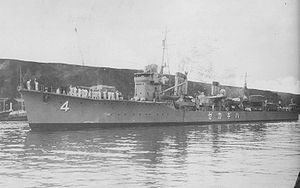- Hagikaze
-
Hagikaze 
El Hagikaze el 31 de marzo de 1941.Banderas 
Historial Astillero Uraga Clase Kagerō Autorizado 1939 Iniciado 23 de mayo de 1939 Botado 18 de junio de 1940 Asignado 31 de marzo de 1941 Baja 15 de octubre de 1943 Destino Hundido el 7 de agosto de 1943 Características generales Desplazamiento 2.033 toneladas como estándar, 2.450 toneladas en pruebas Eslora 118,5 metros Manga 10,8 metros Calado 3,76 metros Armamento • Seis cañones de 127 mm • Hasta 28 cañones antiaéreos de 25 mm
• Hasta 10 ametralladoras antiaéreas de 13 mm
• 16 cargas de profundidad
• Ocho tubos lanzatorpedos de 610 mm en dos lanzadores cuádruples.Propulsión Tres calderas, dos turbinas, dos hélices tripala Potencia 52.000 HP Velocidad 35 nudos Autonomía 5.000 millas náuticas a 18 nudos Tripulación 240 marineros y oficiales El Hagikaze (萩風?) fue un destructor de la Clase Kagerō. Sirvió en la Armada Imperial Japonesa durante la Segunda Guerra Mundial.
Contenido
Historia
Durante la batalla de Midway, el 4 y 5 de junio de 1942, rescató junto al Maikaze a los supervivientes del portaaviones Kaga. Posteriormente torpedeó y hundió junto a otros destructores al portaaviones Akagi, previamente abandonado por su tripulación tras ser dañado más allá de cualquier reparación, con lo que se evitó su captura por los estadounidenses.
El 19 de agosto del mismo año resultó gravemente dañado por un ataque aéreo cerca de Guadalcanal. Una bomba lanzada desde un bombardero pesado B-17 le alcanzó en la torreta de popa, destruyéndola e inundando su santabárbara. También resultaron dañados el timón y los ejes de las hélices, quedando reducida su velocidad a tan sólo seis nudos. Hubo 33 muertos y 13 heridos a bordo como resultado de este ataque. El Hagikaze fue escoltado por su gemelo Arashi hasta Truk, donde el 24 de agosto se iniciaron reparaciones de emergencia.
Como escolta del portahidros Nisshin, fue testigo de su hundimiento en un ataque aéreo el 22 de julio de 1943, rescatando posteriormente a sus supervivientes. El fin del Hagikaze llegó durante la nocturna batalla del Golfo de Vella, el 7 de agosto del mismo año, cuando una flotilla de seis destructores estadounidenses emboscó empleando el radar, lanzando 44 torpedos y posteriormente un nutrido fuego artillero contra cuatro destructores japoneses que realizaban un transporte de tropas del Tokyo Express. El Hagikaze fue hundido junto al Arashi y el Kawakaze. El cuarto destructor japonés, el Shigure, fue también alcanzado por un torpedo en su timón, pero no estalló, atravesándolo de parte a parte.[1]
Véase también
- Buques de la Armada Imperial Japonesa
- Otros buques de la Clase Kagerō:
Referencias
Notas
- ↑ de la Sierra, p. 464.
Bibliografía
- Jentschura, Hansgeorg; Jung, Dieter; Mickel, Peter (en inglés). Warships of the Imperial Japanese Navy, 1869-1945. Naval Institute Press. pp. 148-149. ISBN 0-87021-893-X.
- Chesneau, Roger, ed (en inglés). All the World´s Fighting Ships 1922-1946. Conway Maritime Press. p. 194. ISBN 0-85177-146-7.
- de la Sierra, Luis (1979). La guerra naval en el Pacífico (1941-1945) (cuarta edición). Barcelona: Editorial Juventud. ISBN 978-84-261-1590-4.
- Nevitt, Allyn D. (1998). «IJN Hagikaze: Tabular Record of Movement» (en inglés). Combined Fleet. «Registro de actividad durante la Segunda Guerra Mundial.».
- Nishida, Hiroshi (2003). «Kagero class 1st class destroyers» (en inglés). Materials of IJN. «Datos sobre todas las unidades de la Clase Kagerō.».
Wikimedia foundation. 2010.
